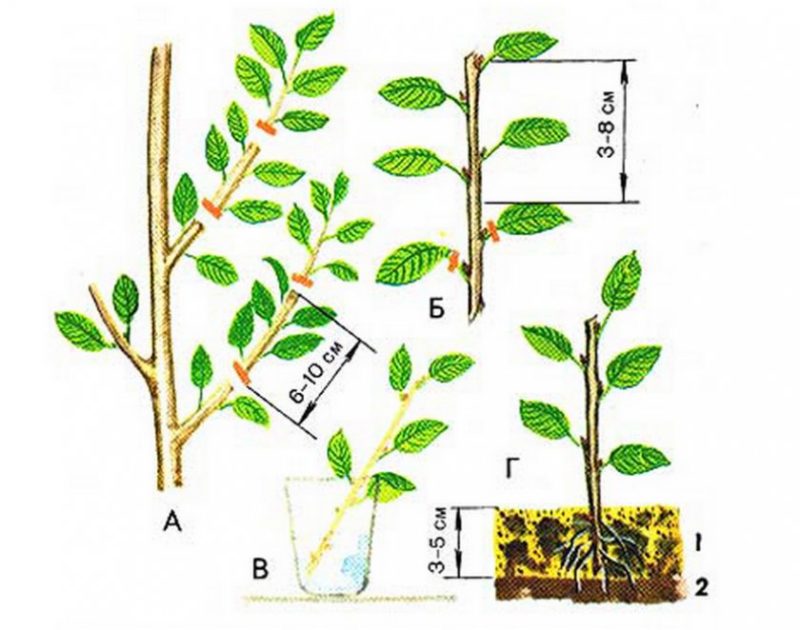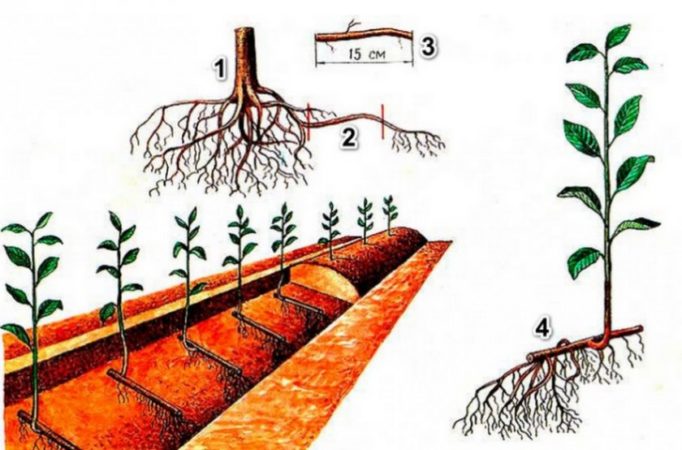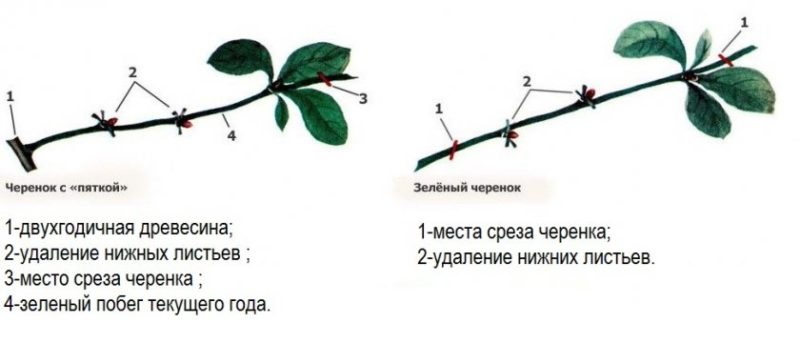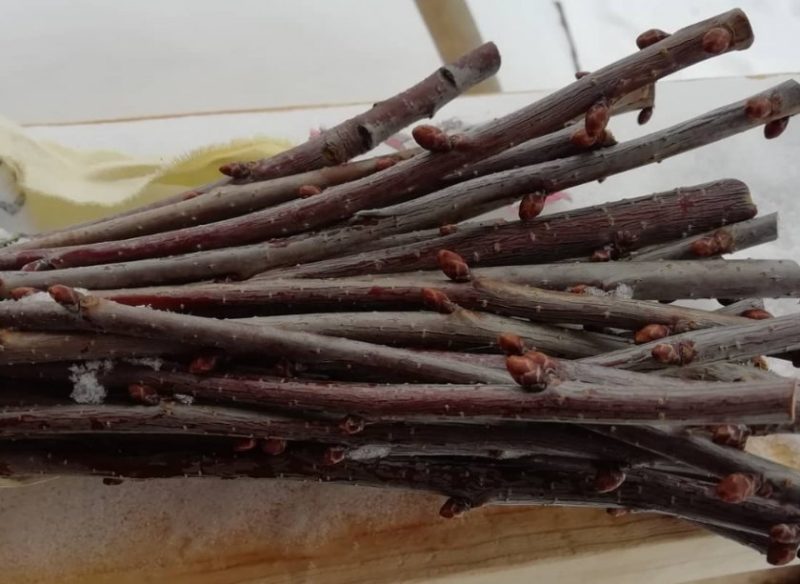DIY step-by-step instructions for cutting cherries in the summer
Cherry is easy to propagate using a vegetative method - cuttings. This is the simplest and most effective method for preserving all valuable varietal qualities in a new plant. Cutting cherries in the summer is within the power of everyone, if you know the features of the procedure and perform it correctly. Consider how to grow cherries from an adult bush in a vegetative way.
The content of the article
Is it possible to propagate cherries by cuttings in summer
Experienced gardeners often use this method when expanding gardens or replacing old or diseased fruit trees.
Cherry responds well to cuttings, while it is important to observe the technology of cutting, rooting and planting the source material. The cuttings take root well, but require care.
Attention!Due to the biological characteristics of cherries (lack of self-fertility in some varieties), it is recommended to grow at least one pair of trees nearby with the same flowering time.
Advantages and disadvantages
It is not always possible to find a suitable seedling, and summer cherry cuttings are an effective solution, which has many advantages:
- preservation of the properties of the mother tree variety: external and taste characteristics, yield, ripening time, resistance to frost and diseases;
- the possibility of independent rapid reproduction of culture;
- simplicity of the procedure that does not require specific skills;
- obtaining several dozen cuttings without damaging the plant;
- saving money;
- confidence in the quality of planting material, as opposed to purchased;
- the formation of a strong root system by the time of planting, which facilitates plant survival;
- rapid growth, entry into fruiting already at 3 years of age.
Of the shortcomings, it is noted that the survival rate of cuttings of many varieties does not exceed 50%. Plants need shelter for the winter, regular and abundant watering, and the introduction of drugs to stimulate growth.
Optimal timing for summer cuttings
Summer is the most active season of work in the country, among which the reproduction of plants occupies an important place. The right air temperature and long daylight hours help accelerate root formation in young plants and their survival.
Cherry cuttings are carried out throughout the summer, but the result will be more effective if the procedure occurs at the beginning of June. During this period, the plant develops most intensively, saturated with nutrients for growth: nitrogen, phosphorus, potassium, carbohydrates.
Auspicious days
Many gardeners cut cherries in accordance with the lunar calendar, which indicates the phases of the waxing, waning moon and favorable days for such procedures.
The starting material for planting is harvested only on the growing moon on the following dates:
- June: 1–4, 21–31;
- July: 24–27;
- August: 1, 2, 20–31.
Suitable varieties of cherries
As a result of cuttings, not all varieties show equally high survival rates.
The most suitable with an efficiency of up to 80% are:
- Vladimirskaya. An ancient (more than 300 years old) and very popular variety in Russia with fruits of medium ripeness. It grows as a large bush (2.5-4 m) with several central conductors and a dense weeping crown.When grafted, it is a single-stemmed tree. Fruits are small, turnip-shaped, weighing a maximum of 3.4 g (usually 2.5–3 g). The variety is characterized by frost resistance, productivity and good transportability. The outer shell of the berry is burgundy, almost black in color, dotted with gray dots. The pulp is dark red, dense, juicy, the taste is pleasant sweet and sour, with barely noticeable tart notes.
- Rastunya. Local variety of the Middle and Lower Volga region of national selection. The tree is tall, with a broad-pyramidal crown of medium density. Bears fruit for 4-5 years. Fruits are small (up to 2.5 g), round, slightly flattened, formed in inflorescences (from 1 to 3), ripen in mid-July. The pulp is dark red, medium density, juicy. The taste is sweet and sour, slightly astringent. A medium-ripening variety with a yield above average, winter-hardy, drought-resistant.
- Nadezhda Krupskaya. The variety is widespread in the Vladimir and other regions of the Non-Black Earth Region. The tree is bush-shaped, reaches a height of 2 m. The crown is dense, rounded, somewhat weeping. The branches are thin, hanging down the sides. The elasticity of their wood allows them to withstand bountiful harvests of large berries. Cherries begin to bear fruit 2-3 years after planting. The fruits ripen mainly in July. The yield is high and annual: an adult tree bears an average of 10-12 kg of berries. Fruits are medium in size (3.5–4 g), the skin is very thin, the flesh is light red. Average winter hardiness.
Selection and preparation of cuttings
How to cut cherries? 2 days before the procedure, the mother tree is watered abundantly so that the plant tissues are well saturated with moisture. The best time for this is early morning or evening.
A higher survival rate in green cuttings taken from the top of the shoots of the current year.
Advice! Gardeners have a way to test the suitability of the planting material for cutting - screw it onto a finger. If it does not break, you can start the procedure.
A young branch is pre-inspected, which should be healthy and without damage. Cuttings are cut with a diameter of 4–5 mm and a length of 5–7 cm so that each has 2 buds. A 1.5 cm cutting is left under the bottom, a cut is made on top directly above the kidney.
A sharp knife or razor is used in the work, since a blunt instrument damages the vascular system of the workpieces. Cut cuttings are immediately dipped in water with bases to prevent the leaves from drying out.
How to propagate cherries with woody cuttings? To do this, at the end of summer, they are cut into lengths of 10–12 cm from annual shoots. The lower cut is made 3–5 mm below the kidney, the upper one - 5–10 mm higher.
The cuttings are tied in bunches, in a cool room they are dropped halfway into sand or wet sawdust and stored until spring. At the same time, the substrate is moderately moisturized, its drying out or blocking is unacceptable.

Cherries are propagated much less often with air layers, but some gardeners resort to this method. Work order:
- In early June, the lower branch of a young tree (thin, unbranched, 3-5 years old) is bent to the ground and pinned.
- Make sure that the shoot lies horizontally.
- The fold area is sprinkled with soil and watered.
A full-fledged root system is formed within a year. Then the cuttings are separated from the mother tree and planted in a permanent place of growth.
A branch for an air layer is taken above the grafting site, as a result, young cherries of a self-rooted type of an identical variety are obtained.
Rooting methods
Before rooting, the cuttings are kept in a solution of a root formation stimulant (Epin, Kornevin or Heteroauxin) for 12-24 hours.
Rooting in soil:
- Take any container: containers for seedlings, cut plastic bottles of 2 liters or specially knitted boxes.
- Fill it with a nutrient substrate from turf and humus (1: 1), add superphosphate, nitrogenous fertilizers and ash.
- Thoroughly moisten and deepen the cuttings by 3 cm, keeping a distance between them of at least 10 cm.
Immediately after planting, the container is covered with a film to create a greenhouse effect and accelerate root formation. A mini-greenhouse is located in a shaded area outdoors or in a bright room with an air temperature of + 22 ... + 25 ° C.
It is important to create high humidity in the greenhouse, therefore, once every 5 days, the cuttings are sprayed with warm water from a spray bottle, periodically watered and ventilated. With proper care, the roots will appear in 2 weeks. It will take the same amount of time for them to take root.
Some summer residents use an easier rooting method. To do this, cuttings kept in a growth stimulator and moistened from a spray bottle are packed in plastic bags and placed in partial shade.
At summer temperatures and high humidity, root rudiments will form. In September, the plants are planted in light soil, in late autumn they are mulched.

Is it possible to propagate a tree with shoots, and will it bear fruit
Is it possible to grow cherries from a shoot? This method is considered the easiest, but only varietal or own-rooted plants are suitable for it.... From their undergrowth, trees will be obtained that will completely retain varietal qualities.
Only strong developed offspring of 1-2 years old are chosen. In early spring, the root is cut from the mother plant. After that, the shoots are shortened by 1/3, watered and fertilized.
In October, cut the root on the second side. After a year, the plant is dug up and transplanted to a permanent place.
Planting ready-made cuttings
After rooting, the finished cuttings are planted in light soil. To prepare the substrate, take garden soil, peat and sand (1: 1: 2). To this mixture add 20 g of superphosphate per 1 kg of earth.
Important! The landing site is chosen slightly shaded and protected from the winds.
The cuttings are planted in the soil to a depth of 3-5 cm, they are placed strictly vertically. The land around is tamped and watered. After absorbing water, mulch with peat.

Features of cuttings depending on the type of cherry
Not all cherry varieties are able to take root.
Well-rooted (80–90%) include:
- Shubinka;
- Zhagarskaya;
- Dawn of the Volga region;
- Vole.
Medium rooted (up to 50%) such varieties:
- Fertile Michurina;
- Half fat;
- Apukhtinskaya;
- Dessert Volga.
Depending on the region
In the middle lane and the southern regions of Russia, where there is a stable snow cover in winter, and the ground does not freeze too much, cuttings are planted in the soil in August.
In harsh climatic conditions, planting is carried out in early June. For the winter, young plants must be sheltered from frost.

Further care
Propagation by cuttings is a relatively simple procedure, but after planting, the plants require care, which includes the following:
- Watering. Young plants need a lot of moisture. The land on the temporary site is constantly moistened, but waterlogging is not allowed. With stagnant water, the root system will begin to rot.
- Top dressing. The cuttings are fertilized every 2 weeks. For this, superphosphate, ammonium nitrate and potassium salt are used. For the early appearance of green shoots, nitrogen is introduced.
- Draft protection. In the first month after planting, the cuttings are covered with a jar or plastic wrap. This helps maintain a relatively stable microclimate. The shelter is removed for a couple of hours every day.
- Warming. For the winter, cuttings are covered with a large layer of sawdust, peat, tops of vegetables or spruce branches.
Experienced gardening tips
To get healthy and strong plants, it is important to heed the advice of experienced gardeners:
- The place of the cut on the shoot is chosen 2 weeks before grafting. It is wrapped in black material 3 cm. This stimulates cell regeneration and increases the chance of rooting by 30%.
- Green cuttings are cut from young trees.
- During fertilization, the cuttings are watered with clean water.
- The cut is made with a sharp knife to minimize damage to the plants.
Conclusion
Reproduction of cherries by cuttings in summer makes it easy and quick to create a new plant.
The main thing is to take a responsible attitude to the preparation of planting material and find the optimal time. Young cuttings need to be regularly moistened and fertilized every 2 weeks, and insulated from frost for the winter.